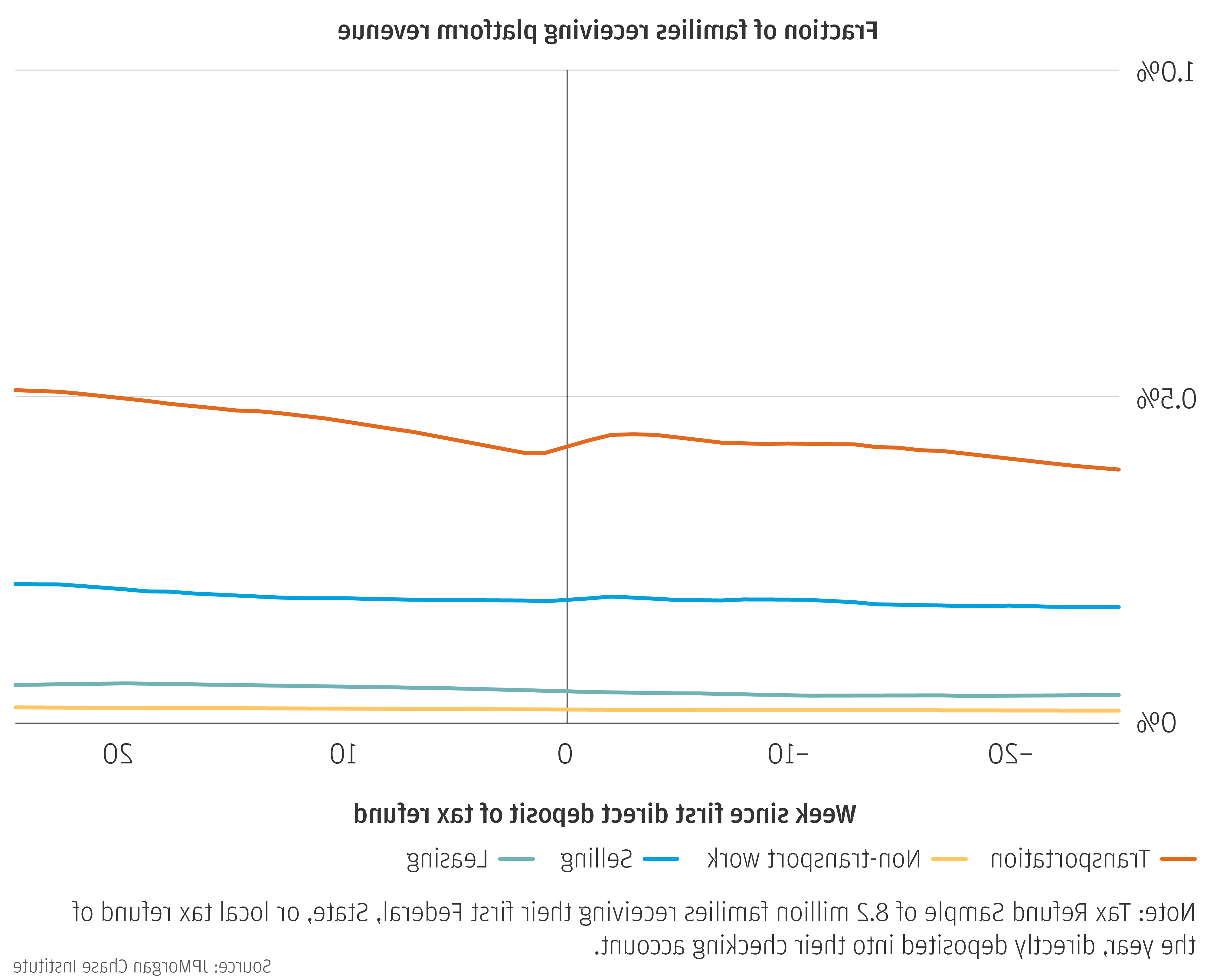请 更新浏览器.
发现
- 去找1Income and cash balances decline by around 10 percent in the ten weeks leading up to a family joining the Online Platform Economy.
- 去找2Employment events catalyze changes in platform participation, 尤其是在交通运输领域. Driver participation and revenues increase when people lose a job and decrease when they gain a job.
- 去找3不像就业的变化, tax-related cash flows have no effect on participation revenues in the Online Platform Economy.
- 去找4Men are more likely than women to use the Online Platform Economy to smooth income through involuntary job loss.
下载
When a family experiences a cash flow interruption, 他们可以通过借贷进行调整, 削减支出, 或者产生额外收入. With the rise of the Online Platform Economy, this last option has likely become more available.
When a family experiences a cash-flow interruption, 他们可以通过减少储蓄来调整, 借款, 削减支出, 或者产生额外收入. With the rise of the Online Platform Economy, this last option has likely become more available. 在这项研究中, we report that supply-side participation in the Online Platform Economy functions as a cash-flow management tool for many families.
We leverage the 澳博官方网站app 研究所 Online Platform Economy data set to investigate whether and how families use the Online Platform Economy to smooth income. We do this by taking two converse perspectives. 第一个, we track the evolution of income and cash balances in the weeks leading up to and immediately following a family’s first joining the Online Platform Economy. 相反, we then track how Online Platform Economy participation rates and average weekly platform revenues evolve around discrete cash-flow events. In total, we analyze five specific events occurring in the years 2016 and 2017:
- 线上平台经济进入: A family receives its first direct deposit from a platform company, indicating that a family member has begun providing labor or capital in the Online Platform Economy. This event was experienced by just over 460,000 families in our sample.
- 失业: A family receives its first direct deposit from the public unemployment insurance system implying an involuntary job loss in the preceding weeks. This event was experienced by just over 170,000 families in our sample.
- 工作收获: A family receives its first payroll direct deposit after two months without payroll income, 暗示新雇佣的家庭成员. This event was experienced by just over 769,000 families in our sample.
- 退税: 一个家庭收到了它的第一个联邦, 状态, 或者当年地方退税, directly deposited into their checking account. 这次事件的经历只有8人多一点.在我们的样本中有200万个家庭.
- 纳税: A family makes its first electronic payment of the year to a Federal, 状态, or local tax authority. 这次事件只有2人多一点.在我们的样本中有400万个家庭.
找到一个: Income and cash balances decline by around 10 percent in the ten weeks leading up to a family joining the Online Platform Economy.
Average cash balances and average weekly take-home payroll income remain roughly constant until about ten weeks before a family begins participating in the Online Platform Economy. 然后, 两者开始同时下降, implying that families may be using liquid balances to maintain their expenditures while missing payroll income. 关于 two weeks before joining the Online Platform Economy, average cash balances and payroll incomes are down almost 10 percent. 政府来源的收入(包括, 例如, social 好处 like unemployment insurance) begin to decline twenty weeks before joining, 但在最后十周跌幅最大.
发现二: Employment events catalyze changes in platform participation, 尤其是在交通运输领域. Driver participation and revenues increase when people lose a job and decrease when they gain a job.
发现三: 不像就业的变化, tax-related cash flows have no effect on participation revenues in the Online Platform Economy.
Tax refunds and tax payments do not catalyze changes in participation in the Online Platform Economy, other than a minor dip in driver participation in the week when a tax refund is received. Nor do families flex their engagement in response to these cash-flow events—例如, by using cash from a refund to buy back some leisure time.
发现四: Men are more likely than women to use the Online Platform Economy to smooth income through involuntary job loss.
Families are more likely to turn to platforms to smooth income around an involuntary job loss if the primary account holder is a man. 不论性别, 然而, families turning to the Online Platform Economy during a spell of involuntary unemployment are most likely to join the transportation sector. 每位司机的平均收入, 以及这些平均值的性别差异, remain stable in the weeks leading up to a first unemployment insurance payment. Notably, the gap increases to about $50 in the weeks after.
结论
综上所述, our findings indicate that the Online Platform Economy—and particularly its transportation sector—play an income-smoothing function for families between jobs. 然而, the tax-related cash flow events do not coincide with changes in platform participation or revenues. These findings add an important dimension to discussions around the design of policy and regulation of these labor markets. 我们看到了四个特别重要的含义:
第一个, as policymakers weigh approaches to improve the pay, 好处, 保护平台工人, they ought to take into consideration potential impacts those same approaches might have on the very characteristics of platform work—low barriers to entry and high flexibility—that allows families to use it to smooth their income. Families in need of an income-smoothing tool may be turning to transportation platforms in particular because barriers to entry on these platforms may be lower than other sectors, and because it may be comparatively easy to generate revenues in the transportation sector with only occasional and periodic engagement. As policy discussions continue around portable 好处 schemes, it is important to consider separately the needs of workers who intend to use platforms or other gigs as a primary source of income over the long-term from those who intend to use them as a temporary income-smoothing tool.
第二个, the Online Platform Economy may be more available as an income-smoothing tool for some families than for others. Women (or family members who share accounts with women) experiencing interruptions to their payroll income are less likely to turn to the Online Platform Economy. To the extent that this difference may reflect structural disparities, it would require attention from both policymakers and platform providers.
第三, although fewer than 1 percent of families experiencing involuntary job loss actually turn to the Online Platform Economy to smooth their income, for those families the additional $150-$250 per week in platform revenues may be crucial. Fully accounting for the additional marginal costs associated with platform participation is likely difficult even for participants, so the extent to which platform participation is effective in generating real income remains unknown. 然而, the additional cash flow may address important immediate needs.
最后, high rates of labor churn in the Online Platform Economy have been taken in some policy discussions as an indication that joining may have proved to be a bad financial decision for many drivers. 然而, our findings imply that one function driving through the Online Platform Economy may play is to bridge a gap between jobs. 在这种情况下, the fact that many drivers find another job and become inactive shortly after joining should not necessarily be interpreted as “voting with their feet” against the viability of the Online Platform Economy as an option for generating income.








